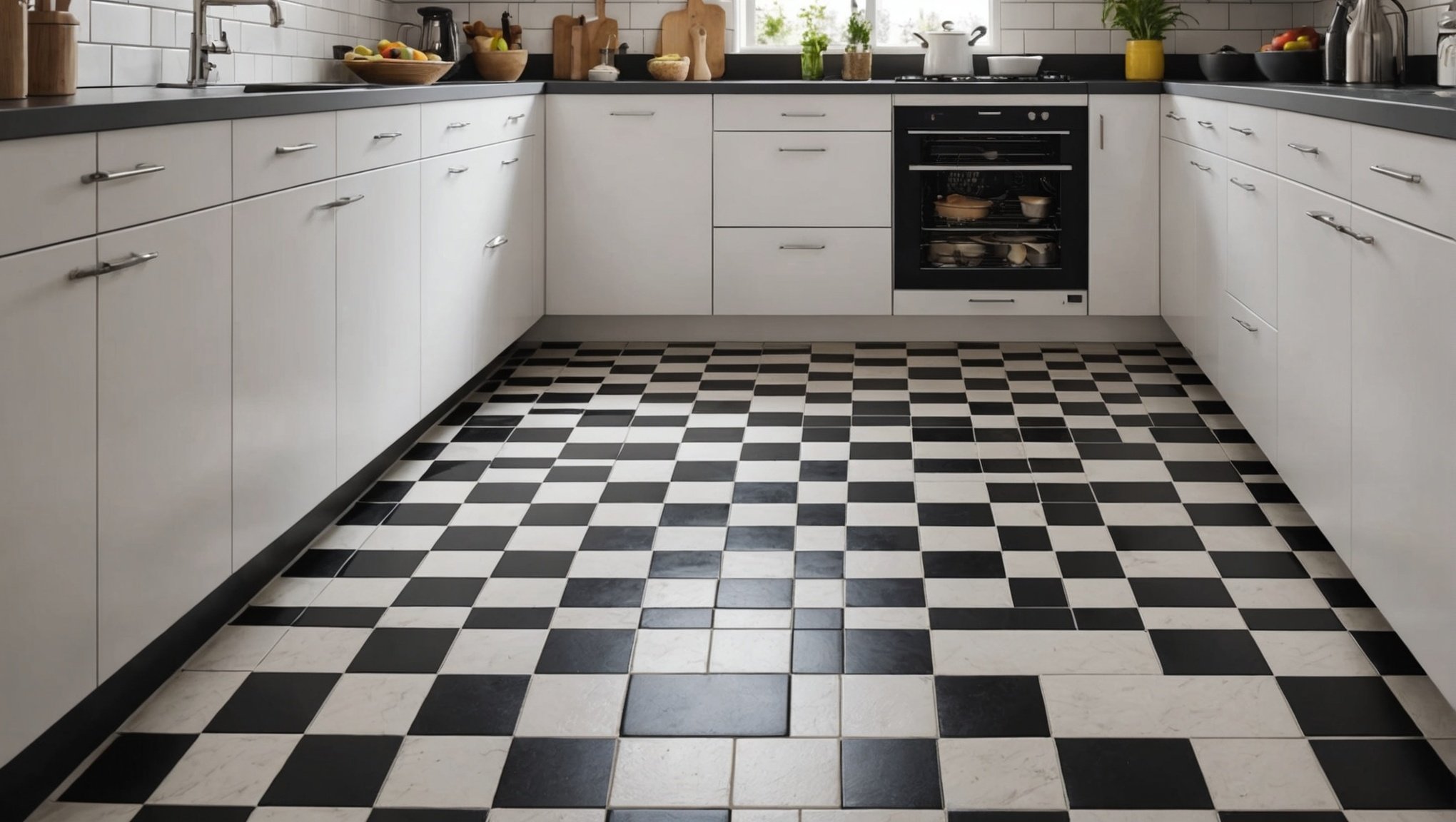Choosing the right kitchen floor tiles is essential for safety and ease of cleaning. Anti-slip tiles not only enhance your culinary space but also provide peace of mind, preventing slips and falls. With various designs available, you can marry functionality with style. Explore our top picks for anti-slip kitchen floor tiles to elevate your cooking experience while maintaining a safe environment. Discover how the right materials can transform your kitchen into a blend of elegance and practicality.
Overview of Anti-Slip Kitchen Floor Tiles
In any kitchen, safety is paramount, and anti-slip kitchen tiles play a crucial role in ensuring a safer environment. Kitchens are bustling spaces where spills and splashes are common, making slip-resistant flooring a necessity to prevent accidents. These tiles provide a secure footing, reducing the risk of slips and falls, which is especially important in homes with children or elderly individuals.
Topic to read : Top Automated Herb Trimmers to Elevate Your Indoor Kitchen Garden Maintenance
The benefits of anti-slip kitchen tiles extend beyond just safety. They offer peace of mind, knowing that your kitchen is equipped to handle the occasional spill without compromising on security. Additionally, these tiles are available in a wide range of styles and finishes, allowing homeowners to maintain aesthetic appeal while prioritising safety.
Various materials are used in the production of anti-slip kitchen tiles, each offering unique properties. Ceramic and porcelain tiles are popular choices due to their durability and water resistance. Natural stone tiles, such as slate or granite, provide a textured surface that enhances grip. Furthermore, vinyl tiles offer a budget-friendly option with excellent slip resistance. By considering these flooring options, homeowners can select the most suitable material for their kitchen’s needs while ensuring a safe and functional space.
In parallel : Top Automated Herb Trimmers to Elevate Your Indoor Kitchen Garden Maintenance
Top Features to Look for in Anti-Slip Kitchen Floor Tiles
When selecting anti-slip kitchen floor tiles, understanding slip ratings is crucial. Slip ratings indicate how effective a tile is at preventing slips, often measured by the Coefficient of Friction (CoF). A higher CoF means better slip resistance, which is vital for kitchen safety. Look for tiles with a CoF of 0.60 or higher for optimal slip resistance.
Durability is another key factor. Kitchen tiles endure heavy foot traffic, spills, and regular cleaning, so choosing durable materials like ceramic, porcelain, or natural stone is wise. These materials not only withstand wear and tear but also maintain their slip-resistant properties over time. Proper maintenance, such as regular cleaning and sealing, ensures your tiles remain effective and visually appealing.
Aesthetic options and design considerations also play a significant role. Anti-slip tiles come in various styles, colours, and patterns, allowing you to match your kitchen’s decor while prioritising safety. From the sleek look of porcelain to the rustic charm of natural stone, there’s a design to suit every taste. By balancing tile features like slip resistance, durability, and aesthetics, you can create a kitchen that is both safe and stylish.
Best Materials for Anti-Slip Kitchen Floor Tiles
Selecting the right tile materials is crucial for creating a safe and stylish kitchen. Among the most popular choices are ceramic tiles and vinyl tiles, each offering distinct advantages.
Ceramic tiles are renowned for their durability and resistance to water, making them a practical option for busy kitchens. They come in various textures and finishes, enhancing their slip-resistant properties. Moreover, ceramic tiles are easy to clean and maintain, ensuring they remain effective over time.
In contrast, vinyl tiles are a budget-friendly alternative that doesn’t compromise on safety. They are softer underfoot, providing comfort during long hours in the kitchen. Vinyl tiles are also available in a wide array of designs, allowing homeowners to achieve their desired aesthetic without sacrificing slip resistance.
Aside from ceramic and vinyl, other materials like porcelain, natural stone, and laminate offer unique benefits. Porcelain tiles are dense and robust, while natural stone, such as slate, provides excellent grip through its textured surface. Laminate, though less common, can be a viable option with appropriate slip-resistant coatings.
For those prioritising sustainability, eco-friendly options are available, including recycled materials and low-VOC finishes, contributing to a greener kitchen environment.
Top Recommendations for Anti-Slip Kitchen Floor Tiles
Choosing the best anti-slip tiles can be daunting, but a curated list of top-rated options simplifies the process. These selections are based on comprehensive product reviews and expert insights, ensuring both safety and style.
Curated List of Top-Rated Anti-Slip Tiles
- Ceramic Tiles: Highly durable and water-resistant, these tiles are praised for their slip-resistant textures. Users appreciate their longevity and ease of maintenance.
- Vinyl Tiles: Known for affordability and comfort, vinyl tiles offer excellent slip resistance. Many users highlight their diverse design options and soft underfoot feel.
- Porcelain Tiles: Dense and robust, porcelain tiles are favoured for their durability and aesthetic appeal. Expert reviews commend their ability to withstand heavy kitchen use.
- Natural Stone Tiles: With excellent grip due to their textured surfaces, natural stone tiles like slate are popular. They add a rustic charm while ensuring safety.
Price Ranges and Value for Money
- Ceramic and Porcelain: Mid to high price range, offering great value for durability.
- Vinyl: Budget-friendly, providing excellent safety features.
- Natural Stone: Higher cost, but offers unique aesthetics and slip resistance.
These recommendations balance functionality, style, and budget, helping you find the perfect fit for your kitchen.
Installation Tips for Anti-Slip Kitchen Floor Tiles
Installing anti-slip kitchen floor tiles can be a rewarding DIY project if approached with the right knowledge and preparation. Here’s a step-by-step guide to help you tackle the task:
- Preparation: Begin by ensuring the subfloor is clean, dry, and level. This is crucial for a successful installation.
- Layout Planning: Arrange your tiles before securing them. This allows you to visualise the final look and make necessary adjustments.
- Adhesive Application: Use a notched trowel to apply a thin layer of adhesive evenly across the subfloor. This ensures each tile adheres properly.
- Tile Placement: Carefully place each tile, using spacers to maintain consistent gaps for grout lines.
While DIY installation is feasible, there are instances when hiring a professional is advisable. If your kitchen has uneven surfaces or intricate designs, professional installation ensures precision and longevity.
Avoid common mistakes such as skipping the subfloor preparation or using incorrect adhesive types. These errors can compromise tile stability and slip resistance. Whether opting for DIY or professional help, understanding these installation tips ensures a safe and visually appealing kitchen floor.
Maintenance and Care for Anti-Slip Kitchen Floor Tiles
Proper tile maintenance is essential for preserving the slip-resistant properties and longevity of your kitchen floor tiles. Regular care ensures that they remain both safe and aesthetically pleasing.
Recommended Cleaning Products and Techniques
To maintain your tiles, use a pH-neutral cleaner, avoiding harsh chemicals that can damage the surface. For everyday cleaning, a mop with warm water and mild detergent is effective. For tougher stains, a mixture of baking soda and water can be gently scrubbed with a soft brush.
Maintaining Slip-Resistance
To keep the slip-resistance of your tiles intact, avoid wax-based cleaners that can create a slippery surface. Instead, focus on thorough cleaning to remove any residue that might reduce grip. Regularly check for wear and tear, especially in high-traffic areas, and replace tiles as needed.
Tips for Extending Tile Longevity
Extend the lifespan of your tiles by sealing grout lines annually to prevent moisture absorption. Use mats in areas prone to spills, like near sinks and stoves, to protect the tiles. Also, ensure furniture has protective pads to avoid scratches. By following these cleaning tips, your kitchen tiles will remain durable and safe for years to come.
Visual Examples of Anti-Slip Kitchen Floor Tiles
Exploring different tile designs can transform your kitchen into a safe and stylish haven. A photo gallery showcasing various styles and layouts provides ample visual inspiration for homeowners seeking to enhance their kitchen aesthetics.
Trendy Designs in Modern Kitchens
Modern kitchens often feature sleek, minimalist designs that incorporate anti-slip tiles. These tiles are available in various textures and finishes, allowing you to achieve a contemporary look without compromising safety. For instance, matte-finished porcelain tiles offer a chic appearance while providing excellent grip.
Colour Schemes and Patterns That Enhance Safety
Choosing the right colour scheme and pattern is crucial in creating a visually appealing and safe kitchen. Light-coloured tiles can make a space feel larger and brighter, while darker shades add a touch of elegance. Patterns such as herringbone or chevron not only add visual interest but also enhance slip resistance by disrupting smooth surfaces.
By considering these elements, you can select anti-slip tiles that align with your personal style and practical needs. Whether you prefer a rustic charm or a modern aesthetic, the right combination of tile designs and kitchen aesthetics ensures a safe and inviting environment.
Comparing Anti-Slip Kitchen Floor Tiles
Choosing the right anti-slip kitchen floor tiles requires a thorough understanding of the available market options. Each material offers unique advantages and disadvantages, influencing your kitchen’s safety and aesthetics.
Pros and Cons of Different Tile Materials
- Ceramic Tiles: Known for their durability and water resistance, ceramic tiles are a popular choice. They are easy to clean and maintain, but they can be cold and hard underfoot, which might not be ideal for prolonged standing.
- Vinyl Tiles: These are budget-friendly and provide a softer feel, making them comfortable for long hours in the kitchen. However, they may not offer the same longevity as ceramic or natural stone tiles.
- Porcelain Tiles: Offering robustness and aesthetic appeal, porcelain tiles are perfect for high-traffic areas. They are, however, more expensive and may require professional installation.
- Natural Stone Tiles: With excellent grip and a rustic charm, natural stone tiles like slate are ideal for safety. They are, however, on the higher end of the price spectrum and might require more maintenance.
When conducting a tile comparison, consider factors such as durability, comfort, and cost to make an informed decision that aligns with your kitchen’s needs.
User Experiences and Expert Recommendations
Understanding the impact of anti-slip tiles on kitchen safety and functionality requires delving into both user reviews and expert opinions. These insights provide a comprehensive view of how these tiles perform in real-life settings.
User Reviews and Testimonials
Many homeowners share positive user reviews about the enhanced safety and aesthetic appeal of anti-slip tiles. Testimonials often highlight the peace of mind that comes with reduced slip risks, especially in households with young children or elderly family members. Users appreciate the variety of styles available, which allows for a personalised kitchen design without compromising safety.
Expert Opinions and Best Practices
Expert opinions emphasise the importance of selecting tiles with a high Coefficient of Friction (CoF) for optimal slip resistance. Flooring specialists recommend regular maintenance, such as cleaning and sealing, to preserve the tiles’ functionality and appearance. Experts also advise considering the kitchen’s specific needs, such as foot traffic and exposure to moisture, when choosing tile materials.
The combination of user experiences and expert insights underscores the significant role anti-slip tiles play in creating a safe and functional kitchen environment. By following expert recommendations and learning from user testimonials, homeowners can make informed decisions that enhance both safety and style.






